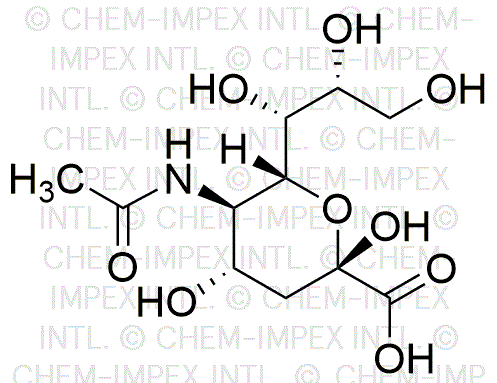N-Acetylneuraminic acid is widely utilized in research focused on:
- Biotechnology: It serves as a key component in the development of glycoproteins and glycolipids, which are essential for cell signaling and recognition processes.
- Pharmaceuticals: This compound is used in drug formulation to enhance the efficacy of vaccines and therapeutic agents by improving their stability and immune response.
- Food Industry: It acts as a natural preservative and flavor enhancer, contributing to the safety and quality of various food products.
- Diagnostics: N-Acetylneuraminic acid is employed in the development of diagnostic tools for detecting viral infections, particularly in the case of influenza and other respiratory viruses.
- Cosmetics: Its moisturizing properties make it a valuable ingredient in skincare products, helping to improve skin hydration and texture.
General Information
Properties
Safety and Regulations
Applications
N-Acetylneuraminic acid is widely utilized in research focused on:
- Biotechnology: It serves as a key component in the development of glycoproteins and glycolipids, which are essential for cell signaling and recognition processes.
- Pharmaceuticals: This compound is used in drug formulation to enhance the efficacy of vaccines and therapeutic agents by improving their stability and immune response.
- Food Industry: It acts as a natural preservative and flavor enhancer, contributing to the safety and quality of various food products.
- Diagnostics: N-Acetylneuraminic acid is employed in the development of diagnostic tools for detecting viral infections, particularly in the case of influenza and other respiratory viruses.
- Cosmetics: Its moisturizing properties make it a valuable ingredient in skincare products, helping to improve skin hydration and texture.
Documents
Safety Data Sheets (SDS)
The SDS provides comprehensive safety information on handling, storage, and disposal of the product.
Product Specification (PS)
The PS provides a comprehensive breakdown of the product’s properties, including chemical composition, physical state, purity, and storage requirements. It also details acceptable quality ranges and the product's intended applications.
Certificates of Analysis (COA)
Search for Certificates of Analysis (COA) by entering the products Lot Number. Lot and Batch Numbers can be found on a product’s label following the words ‘Lot’ or ‘Batch’.
*Catalog Number
*Lot Number
Certificates Of Origin (COO)
This COO confirms the country where the product was manufactured, and also details the materials and components used in it and whether it is derived from natural, synthetic, or other specific sources. This certificate may be required for customs, trade, and regulatory compliance.
*Catalog Number
*Lot Number
Safety Data Sheets (SDS)
The SDS provides comprehensive safety information on handling, storage, and disposal of the product.
DownloadProduct Specification (PS)
The PS provides a comprehensive breakdown of the product’s properties, including chemical composition, physical state, purity, and storage requirements. It also details acceptable quality ranges and the product's intended applications.
DownloadCertificates of Analysis (COA)
Search for Certificates of Analysis (COA) by entering the products Lot Number. Lot and Batch Numbers can be found on a product’s label following the words ‘Lot’ or ‘Batch’.
*Catalog Number
*Lot Number
Certificates Of Origin (COO)
This COO confirms the country where the product was manufactured, and also details the materials and components used in it and whether it is derived from natural, synthetic, or other specific sources. This certificate may be required for customs, trade, and regulatory compliance.


